JN0-662 Online Practice Questions and Answers
You want to add a new OSPF area to your existing OSPF network, however, this area will not be directly connected to Area 0. Which feature would you use to complete this task?
A. a routing policy
B. not-so stubby area
C. virtual link
D. Type 10 LSA
With which two elements is a VRF table populated? (Choose two.)
A. Routes received from remotely connected CE sites.
B. Routes received from directly connected CE sites.
C. Routes received from P routers with acceptable MP-BGP attributes.
D. Routes received from PE routers with acceptable MP-BGP attributes.
Click the Exhibit button.
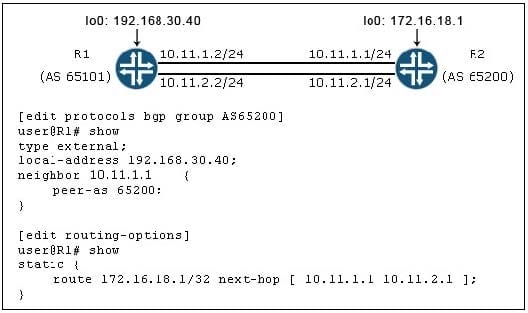
Referring to the exhibit, what must be added to the existing configuration to ensure that per-prefix load balancing occurs?
A. multihop
B. keep all
C. multipath
D. family inet unicast
You are asked to deploy VPLS in your network as a new service for several customers, and you must identify the configuration and provisioning requirements for your customers. Which two statements are correct in this scenario? (Choose two.)
A. CE interfaces facing the service prowler must be Ethernet interfaces.
B. VLAN IDs defined on CE interfaces must be the same on both ends unless otherwise negotiated.
C. CE interfaces facing the service provider must be Layer 3 interfaces.
D. PE interfaces facing the core must have VPLS encapsulation enabled.
You want to reject routes from any BGP peers that have prepended their AS path.
What is the correct as-path regex that would allow you to accomplish this task?
A. 65001.*
B. .{2,}
C. (65001|65001|65001)
D. .{0,1}
Click the Exhibit button.
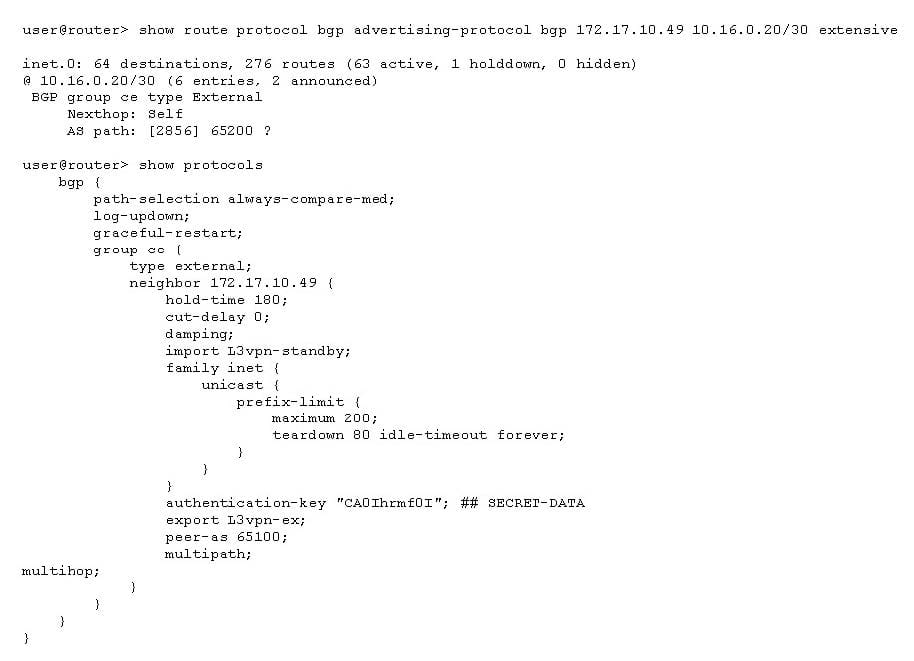
The route shown in the exhibit is being advertised to the EBGP peer and displays a next hop of itself. However, you do not have a next-hop self policy configured. What would cause this behavior?
A. The IBGP peers have a next-hop self policy, which the router is exporting to the EBGP neighbors.
B. The set protocols bgp path-selection as-path-ignore is not set and must be added so the next-hop attribute will propagate from the peer.
C. The set protocols bgp accept-remote-next hop is not set and must be added so the next- hop attribute will propagate from the peer.
D. The next-hop attribute was modified by default when it was advertised to the EBGP peer, without applying a policy.
How is a BGP Layer 2 VPN prefix formed by a PE?
A. by combining the route distinguisher and vrf-target, in that order
B. by combining the route distinguisher, remote site identifier, and site identifier, in that order
C. by combining the route distinguisher, site identifier, and remote site identifier, in that order
D. by combining the vrf-target and route distinguisher, in that order
Click the Exhibit button.
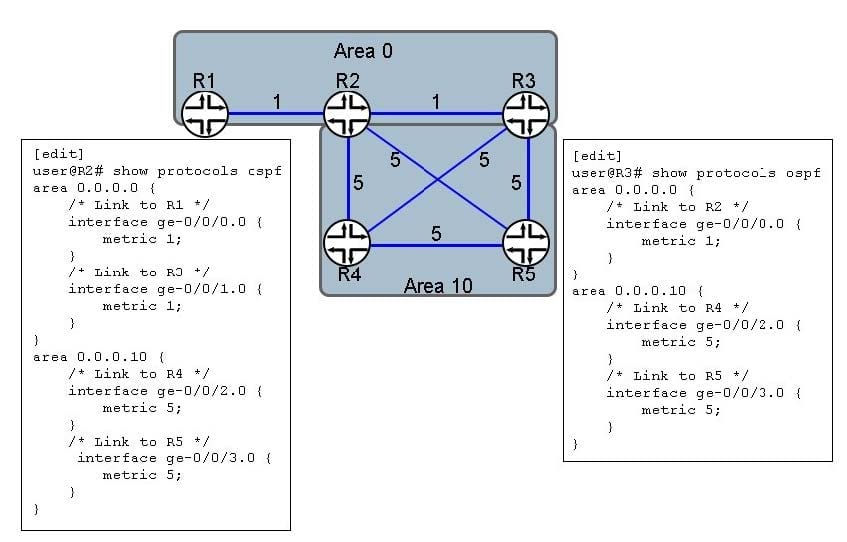
You have the multi-area OSPF network design shown in the exhibit.
Which path will traffic from R1 transit to reach R4 if the R2-R4 link fails?
A. R1-R2-R5-R3-R4
B. R1-R2-R3-R5-R4
C. R1-R2-R3-R4
D. R1-R2-R5-R4
Which two types of LSAs have a domain scope? (Choose two.)
A. Type 7
B. Type 2
C. Type 10
D. Type 5
Click the Exhibit button.
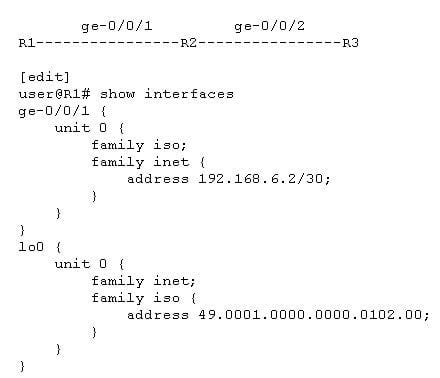
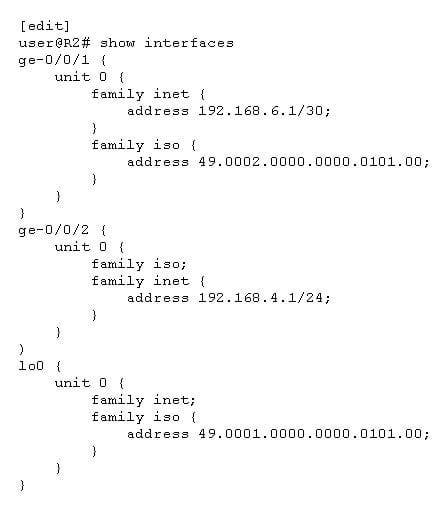
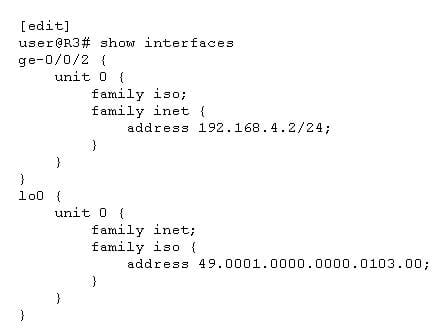
Routers R1, R2, and R3 have set protocols isis interface all configured and no other set protocols isis configuration.
Referring to the exhibit, which two statements are true? (Choose two.)
A. The R2-R3 link will form a Level 1 and Level 2 adjacency.
B. The R1-to-R2 link will only form a Level 2 adjacency.
C. The R1-to-R2 link will form a Level 1 and Level 2 adjacency.
D. The R2-R3 link will only form a Level 1 adjacency.
Which two statements are correct regarding site IDs and circuit IDs in a VPLS routing instance? (Choose two.)
A. In an LDP VPLS routing instance, vpls-id parameters must be different in each location.
B. In an LDP VPLS routing instance, the vpls-id parameters must match in all locations.
C. In a BGP VPLS routing instance, the site-id parameters must be different in each location.
D. In a BGP VPLS routing instance, the site-id parameters must match in all locations.
You are asked to configure PIM-SM in your network. Your implementation must allow for load sharing between redundant RPs and, should an RP failure occur, the RP failover time should be minimized.
Which two configuration tasks are required in this scenario? (Choose two.)
A. Configure MSDP peering sessions between the routers designated as RPs.
B. Configure the shared anycast address on the RPs as the primary address on the loopback interface.
C. On the routers designated as RPs, configure the shared anycast address on the loopback interface.
D. Configure at least two static RPs and bundle them in an RP redundancy group under [edit protocols pim].
Click the Exhibit button.
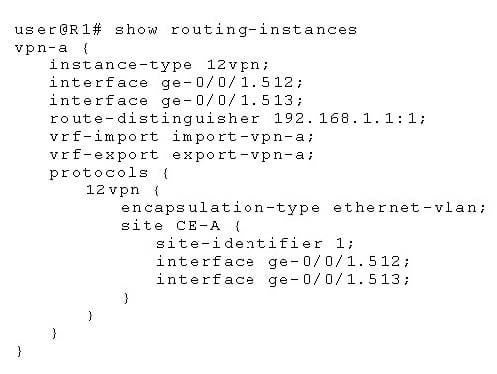
You have configured a BGP-signaled Layer 2 VPN with the configuration shown in the exhibit. Which two statements are true in this situation? (Choose two.)
A. Remote site 1 is dual-homed.
B. The local site is site ID 1.
C. The route-distinguisher is in the wrong format.
D. Interface ge-0/0/l.512 is connected to the local site
Click the Exhibit button.
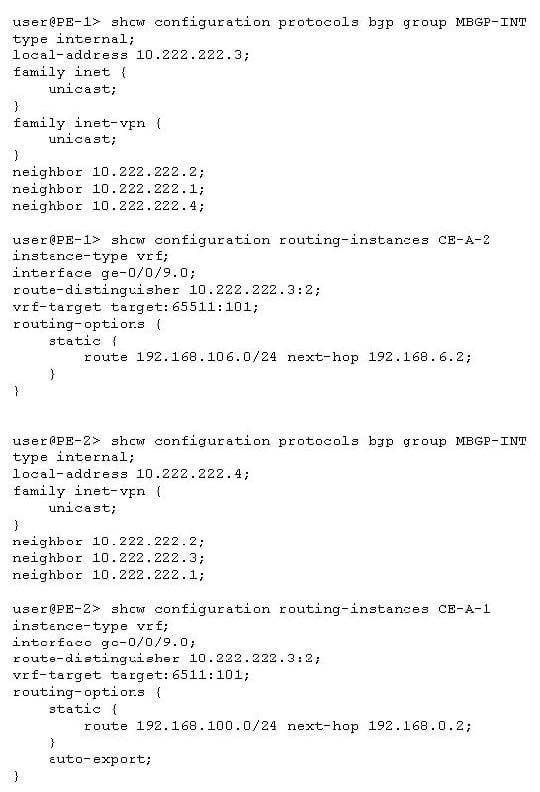
The customer's hosts cannot communicate across their Layer 3 VPN. The exhibit shows the configuration for the two PE devices in the Layer 3 VPN.
What should you do to solve the problem?
A. Add the family INET unicast NLRI address family in the BGP group for PE-2.
B. Set the route distinguishers to be different for PE-1 and PE-2.
C. Add the auto export feature in the routing instances for PE-1.
D. Set the VRF target to the same value on PE-1 and PE-2.
You are configuring a BGP-signaled Layer 2 VPN service. Which two statements are true in this scenario? (Choose two.)
A. RSVP-signaled LSPs are required.
B. The family 12vpn auto-discovery-only parameter is required for BGP sessions.
C. The family 12vpn signaling parameter is required for BGP sessions.
D. RSVP-signaled or LDP-signaled LSPs may be used.
